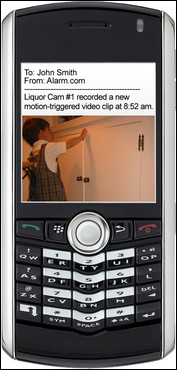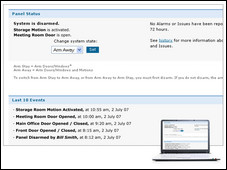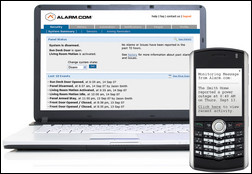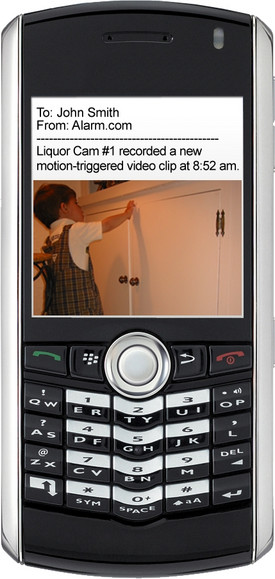Twenty years ago, the goal of a home security system was to prevent break-ins. Motion sensors and glass breakage sensors worked with alarms and keypads to
 HAI’s Omni Pro II features built-in UL listed security and fire systems, lighting control, temperature control, audio control and more. |
keep burglars out and notify police and/or fire departments in case of a break-in or fire.
Today’s security systems still work to maintain home safety. But they also help save money on energy costs, allow you to manage and monitor your house whether you’re home or away, and keep track of kids and elderly relatives. “Security systems used to do one thing and do it well,” says Tony Barra, partner in Poco Labs in Novi, Mich. “Now, security systems are connecting more to lifestyles.”
In the past, a security system noted if a motion sensor was tripped or the homeowner set the system in ‘away’ mode. But the system user didn’t have access to the information. Now, you can access and utilize that information to manage and improve your life.
“Your security system knows your schedule,” says Thomas Pickral Jr., manager of business development for Home Automation Inc. (HAI) in New Orleans, La. “It knows where you are in the house. Generally, it doesn’t do anything with that information. But now system designers can write a computer program using information from those sensors.” For example, a program could note that the house was in ‘away’ mode and immediately set the home’s temperature higher in summer or lower in winter to save on utility bills.
Getting Started
Count on spending $4 to $5 per square foot of your home’s size for a system that includes comprehensive security and home management features as well as stereo and audio, Pickral says. For a 2,000-square-foot home, the cost would be about $10,000. But you could easily start with a basic system with limited features for several hundred to several thousand dollars and upgrade later.
It’s much easier to add wiring before a home has been sheetrocked and painted than after. It’s even better to involve the automation specialist in the design. Then, you can even plan a small closet just to house the system controls. A good time to add or upgrade home automation is when you’re remodeling your house because you or your contractor are likely to be tearing up walls then anyway.
But whether you’re remodeling or not, if your home is already built, it’s a good idea to work with a company that specializes in dealing with the issues involved in retrofitting alarm systems to existing homes. First, you’ll have to find a place to house the system’s controls—most likely in a closet or pantry. Then, you’ll have to find the best way to run wires to the controller, which is a harder
task when a home has been finished. “There is a small but highly vocal do-it-yourself home automation market,” Pickral says. “They use the Internet to find answers. But most of these products are designed for professional installers.” What’s most important, though, is finding a retrofit specialist,” Pickral says. “Retrofitting wires is more of an art than a science.”
 An Alarm.com system alerts the owners that someone has opened a liquor cabinet. |
If you want to upgrade your system, you may be able to build on what you have or you might have to start with new components. “When we design new products, we try to design them so installers can use wires already in place whenever possible,” Pickral says. But if you want to tie in a surveillance camera, you would have to have one of HAI’s newer systems, he says.
“Plan not only for the home automation you want now but consider what you’ll want in the future. “Most system designers plan for future expansions,” Pickral says. “Part of working with a good contractor is taking a hard look at the life cycle of the product, which might be 20 or 30 years. Determine how the lifestyle of the family is going to change over the next 20 or 30 years.”
Wires or Wireless
Wires offer better performance, Barra says. But wireless systems have become less expensive and easier to install. A wired system is also vulnerable to a pair of scissors cutting the phone line, says Mary Knebel, spokeswoman for Alarm.com, a company founded in 2000 that sells wireless and Web-managed comprehensive security systems to residential customers across the United States and Canada. “A wireless system is independent of any other,” she says. “It allows two-way communication through a smart radio.”
A wireless system is the system of choice, especially for those who don’t use landline phones at all. “The office I work in has a lot of engineers in their 20s,” Knebel says. “They’ve never had land lines. They all use cell phones. With a traditional wired system, if you don’t have a land line, there’s no way to call the monitoring station.”
Safe and Secure
Being safe remains a key function of a home security system, and making your home visible is critical. “Burglars don’t want to be seen,” says Dave Simon, spokesman for Brink’s Home Security. Sensor-triggered lights that come on when someone enters your yard may send a thief looking for an easier target.
 An Alarm.com system can tell the owners who disarmed the alarm and when. |
Motion detectors also monitor people moving around inside your home. If you have pets or small children, you can get motion detectors set to trip only above 50 pounds or even above 90 pounds, Pickral says.
Fire Safety Sight and Sound
Lighting plays a key role now in fire safety, too. Inside, your system can be designed so that when a fire alarm goes off, lights leading to exits are automatically turned on so your family can easily escape the house.
Outside, your fire alarm system can be linked so that lights flash in front of the house and yard in the event of a fire to easily alert fire fighters where to stop. “Normally, the fire department gets the address from a central monitoring station,” Pickral says. “Especially at night, it’s difficult to tell which house is the address. The flashing lights make a beacon.”
To alert you in the event of fire, a home security system can work with smoke detectors; heat detectors and/or dual detectors that react to both heat and smoke. (Often, the dual detectors are still called smoke detectors). In attics, many people use a heat detector only because dust in the air could trigger a smoke detector. Heat detectors are a good idea in case of a fire that doesn’t generate excessive smoke, Pickral says.
A siren linked to your security system can alert you and your family to a fire. But to make sure your children know what to do, you also can custom record phrases in your own voice, such as: “There’s a fire! Get out of the house!”
New technology further integrates the security system with your HVAC system. “In the event of a fire, HAI’s system automatically turns off the heating/AC f so you’re not spreading smoke throughout the house and throwing fresh air on the fire,” Pickral says.
Alarm.com’s wireless GE smoke detector has a photoelectric smoke sensor as well as a built-in fixed temperature/rate-of-rise eat sensor. Other features include a tamper switch, built-in sounder, and a large test and silence button.
Customized Threat Alerts
Thanks to new technology, you can get two levels of monitoring. Your alarm company’s central station will track outside threats such as fires and intruders. Additionally, you can be personally alerted by phone or email to changes in your
 An Alarm.com system can tell the owners who disarmed the alarm and when. |
home even when your alarm system is disarmed. “A typical consumer home has threats that have nothing to do with intrusion or fire,” Knebel says. “You can monitor your liquor cabinet, your medicine cabinet, your pool gate, [even] your gun cabinet.”
Keyed Up
The good news about security keypads is they’re becoming both more sophisticated and easier to use. Your alarm system can link to a simple key fob similar to what you use for your car alarm. Another option is a touch screen interface that can control not only basic security but also numerous other functions such as light, temperature and even your stereo. Or, you can get a key card similar to what you use to in many hotel rooms. You can access your system remotely with a touchtone telephone, online or through a smart phone. “There are very few limitations these days,” Pickral says.
Save Money
Your security system can also help you save money on heating and cooling. “If you set your system in ‘away’ mode, the system knows you’re not there and you can save energy and power,” Barra says.
A programmable thermostat is great for people whose hours away from home are predictable. But people whose schedules vary may prefer to link their security system to the thermostat. When the system is in ‘away’ mode, it automatically adjusts the thermostat up or down, depending on the season. So, if you opt for a rare night on the town, you won’t have to remember to change the program.
“Managing the temperature on your thermostat can save you 10 to 15 percent on your energy bills,” Pickral says. “If you integrate the thermostat into your security system, you don’t have to remember to adjust the thermostat when you leave. When I left the house this morning, I armed the alarm and the system changes my thermostat. When I get home and disarm the alarm, the house goes back to a comfortable temperature.”
Reduce False Alarms
False alarms are a major concern of law enforcement agencies, monitoring companies and consumers. Security system manufacturers are looking for any way they can reduce false alarms and still maintain consumer safety, Knebel says. Some systems are set up so you can press a button on your phone and disable the alarm immediately if, for example, you remember you forgot to give your housekeeper the access code, she says.
Since some burglars will break the alarm panel, Alarm.com has added a feature that will send a signal back to the monitoring company if something is irregular such as a smashed alarm panel. A company representative will immediately call the customer and ask for a password to make sure everything is fine.
The Kids Are All Right
Parents who worry about older children or teenagers home alone can set up their system to notify them when the alarm is disarmed after school. “When the son swipes the keycard to turn off the alarm, his father gets a text message,” Pickral says. “If it gets to be 4:45 p.m. and he hasn’t gotten the message, he can make a phone call.”
 An Alarm.com security system can send you a message if there’s a power outage and/or a water leak at your home. |
You can also use a camera, hidden or not, to check on a caregiver. “No one believes they would need a camera or they certainly wouldn’t have hired that caregiver,” Barra says. “But it’s a comfort to be able to peek in between meetings and see the children playing blocks. It’s becoming more acceptable to have cameras in your home and the price is coming down.” A four-channel video recorder costs just over $1,000 and cameras can range from $50 to $500, Pickral says.
You can even have a TV channel dedicated to the security system. HAI’s systems can give you a dedicated channel so that you can see whatever the camera sees—whether you’re at work monitoring a caregiver or in your own home keeping track of an older relative. Or, you could have a Web page on the television screen giving you updates and that you could interact with via remote control, Barra says. Alarm.com systems offer similar options, such as live video from one or more cameras.
Monitor Elderly Relatives
If you are concerned about elderly parents or grandparents home alone all day, or if you’re worried about your own health, you can set up your security system so that, for example, someone is notified by phone, text message or email if a bathroom and/or kitchen light hasn’t been turned on by a certain time of day, if there is no motion in a certain room by a set time or if an exterior door is left open longer than a set amount of time, Pickral says.
“People want to age in place,” Barra says. “They don’t want to go into assisted living. They don’t want to be a burden to their children who may be in their 50s or 60s and may not be local. You can tie the system into their normal pattern of behavior.”
It was this kind of concern that prompted John Nevin and his three siblings to set up such a system, through Alarm.com, for their widowed mother, who turns 70 this year.
Each sibling has customized the system to be alerted to as many or as few changes inside the home as he or she wants. “We can get an email and see Mom came down for breakfast,” Nevin says. “We can see that Mom took out the garbage. We have motion sensors so we can tell if she’s moving around the house. Or, I can just go to the system and see if there’s been any activity and see what she’s been doing. Mom lives in Michigan and we’ll see on the news they have a foot of snow. Then we’ll get an email and see she’s okay. It gives us peace of mind. Plus, it’s a nice reminder. When you’re busy, it’s easy to forget about somebody. Then my Blackberry goes off and there’s Mom. Sometimes it’s a reminder that I need to give her a call. And I can call when I know she’s in the kitchen.”
Forgot Something? Not to Worry
If you’re always wondering at work whether, for example, you unplugged your iron or curling iron, you can program your system to turn off a certain outlet or outlets when the security system is in ‘away’ mode, Pickral says. You can also check your system to see if you left your garage door open, but you can’t close the door unless you’re nearby, Barra says.
Reduce Fraud
Homeowners can also use their systems to save money by reducing fraud. “We’ve had owners of second homes identify fraud,” Knebel says. “Property managers said the homes weren’t rented and pocketed the cash.” But the system clearly showed people were in the home at the time.
Homeowner Timothy Gallagher of Lindenhurst, N.Y., capitalized on the monitoring capabilities and activity logs for his system, made by Alarm.com, to recover money from a dishonest contractor remodeling his kitchen. The contractor accepted the first two payments for the job. But after four weeks, Gallagher’s kitchen was still torn up and the contractor had made very little progress. “The contractor would say, ‘I was there almost all day; I left at 3 p.m. but I forgot to reset the alarm,’ ” Gallagher said. But motion sensors in the home showed activity for only about 45 minutes. After being confronted with the activity logs, the contractor returned most of the money Gallagher paid him.
Water, Water Everywhere
Anyone who has ever had a water leak or power failure while away from home knows how quickly damage can be done. Now your security system can include moisture sensors under the sink as well as near the dishwasher, washer and hot water heater. If there’s a leak, the system sends a signal to automatically turn off the water to the house, Pickral says. “We saved one customer at least $5,000 in water damage,” Knebel says. “They had a water sensor in the basement. They got notice there was a flood in the basement and the water was turned off.”
You can also set up your system so you can be notified if there’s a power failure so you can save food in the freezer and prevent pipes from bursting in the winter.
With the right home automation system, your house can keep you safe from intruders and fires, save you money and offer an improved lifestyle—all at the push of a button.
Credit: Renovate Your World




























